
Daisy Spoke has started some new adventures!
Here is Episode 2 of The Great Backpacking Adventure in which I turn to overnight hiking to learn more life lessons through an outdoor adventure lifestyle – GIRRAWEEN HERE WE COME!
My year of adventure
Being a year that I’ve devoted to adventure, I’ve been consciously seeking opportunities to push myself out of my comfort zone and expand my inner world. A life of adventure is so much more inviting than a life of being limited by fears and self-imposed routines. So I found myself, rather surprisingly, publicly announcing my intention to have a go at overnight hiking, an activity that in the past has always brought the question to my mind “Why?” I mean, backpacking never really made much sense to me – deliberately burdening yourself with a heavy weight on your back, being completely self-reliant in every aspect, and ….. (and this is a big issue …..) not having access to showers and toilets! Honestly, why would you do this? Where is the fun factor in that?
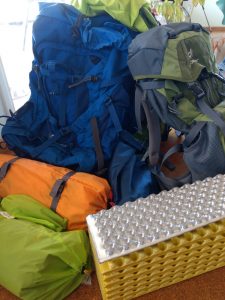
Looking for my next big challenge
Well, funnily enough, on my life-long journey of self-discovery I’ve come to see that it’s very often the really tough stuff that gives me that sense of being fully alive, an elated feeling that comes with achievement and pushing my limits, rising to a challenge and then reflecting on how I’ve grown because of it, and bringing about a sense of fun. Was backpacking the next big challenge I needed in life to learn to let go of the excess physical and mental stuff that I’ve become attached to, and develop independence and self-confidence in who I am? I started to realise that the stories I’d been telling myself about backpacking, were simply stories; not factual stories at all – simply fiction, made up in my mind keeping me small and stopping me from having a go at something that might turn out to be fun after all.

The value of goal-setting
And so with my public announcement of my overnight hiking goal, I began to get myself organised. I decided to share my experience here because I want people to know how valuable goal-setting can be; that we can learn so much more beyond what we expect; and that sometimes goals are uncomfortable, sometimes we lose our way, sometimes we change direction or even miss our target altogether. With goal-setting comes a fear of failure, of not being good enough, a fear of giving up – issues I’ve been working on for myself over the past few years, and now here is my perfect chance to put it all together and see what I can do!

1st Step – Research!
First started the research – reading and watching books, blogs, vlogs and videos. I began asking questions of others, looking in hiking stores, talking with family and friends about the idea. And pretty soon my goal began to take root and blossom. Yes there have been many doubts and worries along the way, but I knew I was doing this for me. To be the best me I can be, to learn from going through the process even if I didn’t like it and even if I decided not to go through it again. I never said I had to like overnight hiking or keep doing it. I simply said I wanted to try it on for size and see how it fitted for me.
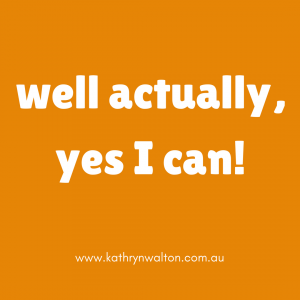
2nd Step – Skills Development!
Secondly I embarked on a project to prepare myself with skills to become more bush-savvy. I participated in an introductory and then an intermediate level navigation and trekking workshop for women. Wow, this was amazing! So many other women of all ages, immersing themselves in a lifestyle of outdoor adventure, choosing to skill themselves up and push their limits! Knowing I was not alone was as important as the actual navigation skills I gained from the workshops.
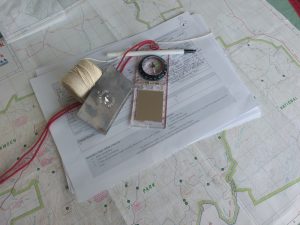
Girraween, here we come!
Finally, with all the right conditions in place – fine mid-season weather, a committed crew of family, a convenient vacancy at the dog boarding kennels for little Tommy, no bushfires, no sickness or injury that would prevent us from going (although it was definitely touch and go for a while!), school assignments done and dusted for the term – we set off for Girraween National Park. This is one of my favourite places to retreat to. Being not far from home it’s kind of like my other backyard.
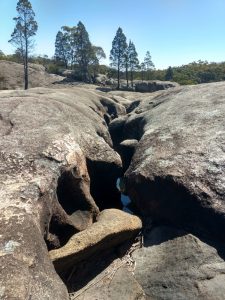
Planning for minimal risk
We had planned our adventure to be a gentle introduction to overnight hiking. We chose marked trails in a National Park we were familiar with so we knew we wouldn’t get lost and would have easy access to help if we needed it. With minimal travel time, low chance of rain and a fairly short distance to walk, we were pretty sure we’d survive the weekend and be home in time for dinner on the Sunday!
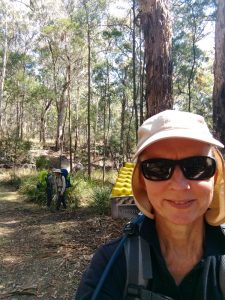
What have I got myself into?
Hauling our packs onto our backs at our starting point on Saturday was pretty daunting. I was having serious doubts about my very sore foot that had been under treatment but it had flared up again. I groaned under the weight of my pack and secretly feeling nauseous at the idea of what I’d gotten myself into. But we set off, slowly plodding along the established trails stopping regularly to soak in the beauty all round us. Only a few minutes into our adventure we saw a big shiny red-bellied black snake slithering gracefully through the undergrowth – a reminder to stay alert at all times.
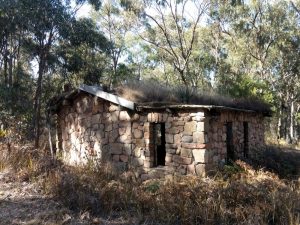
The first day
We walked 14 kilometres on Saturday at a leisurely pace, munching on homemade protein balls, trail mix and wraps whenever we were hungry. From Underground Creek past West Bald Rock and onto the Stone Cottage, we felt like we were in our own little world. We set up camp in the late afternoon feeling somewhat weary but cheerful. I had pre-cooked our dinner, a result of choosing not to invest just yet in a lightweight stove. It always amazes me how good the most basic food can taste when you’ve been physically active all day.
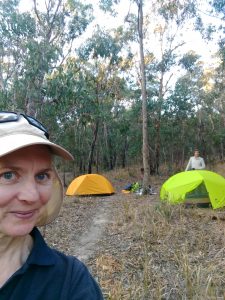
Watching the sun set and the moon rise was a perfect end to our day as we crawled into our tents to sleep. But oh! the fun and games of getting those inflatable pillows ‘just right’!
The second day
Morning brought us slowly to our feet, still aching from the day before. With time to potter around the campsite exploring our surroundings we gradually wound ourselves up for more walking. Having consumed most of our food and much of our water, we were relieved to haul our packs on our backs again and find the weight much more agreeable. As we walked along the Peak and Creek Trails we were fascinated to see how different everything appeared compared to when we’d ridden our mountain bikes through here. We chatted with some other walkers along the way and arrived back at Underground Creek for lunch, a pretty easy 10 kilometre stroll along gently undulating terrain with spectacular views of Mt Norman, other granite structures and an array of spring wildflowers.
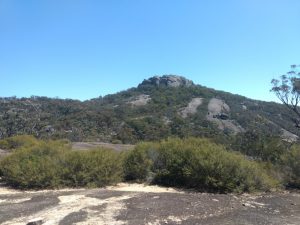
I’d read stories about crows and currawongs pilfering bushwalkers’ backpacks, and was astonished to be caught out myself when I put my pack down to explore the marvellous formations of a granite outcrop. My trail mix was the object of its fascination, tearing into the ziplock bag through the side mesh pocket on my pack. A pretty obvious lesson learned!
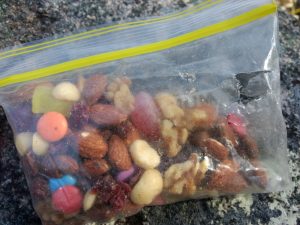
What! Is it already time to go home?
Our weekend adventure seemed to be over all too soon. We couldn’t bear to think we’d have to get back into the car and drive off when it felt like we had only just begun! So we sauntered down to Dr Robert’s Waterhole and gazed at the reflections in the water for some time, extending our time as long as possible. I wonder what adventures the First Nations People have had in this stunning landscape, and what adventures other hikers, landowners and picnickers have had here throughout time as well.
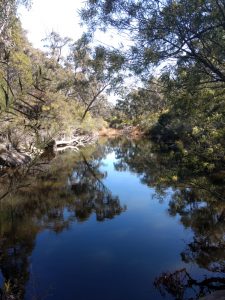
A new series of adventures begins
We knew right then that our overnight hiking adventure was just the first episode in a whole new series of adventures for us. The doubts, the lack of toilets and showers, the physical and emotional challenges were not going to keep us living a small life. Bring on the next adventure I say!
Discovering mountain biking as life’s ultimate parallel universe in her middle age,  Kathryn Walton shares information and reflections in Daisy Spoke that connect, inspire and self-empower women to make healthy choices for themselves. She integrates her love of physical exercise, family, nature, gardening and creative arts with her professional background in mental health social work to facilitate change with individuals, groups and communities of women who are committed to living life to the full.
Kathryn Walton shares information and reflections in Daisy Spoke that connect, inspire and self-empower women to make healthy choices for themselves. She integrates her love of physical exercise, family, nature, gardening and creative arts with her professional background in mental health social work to facilitate change with individuals, groups and communities of women who are committed to living life to the full.
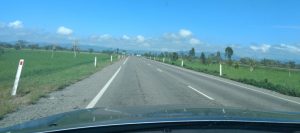
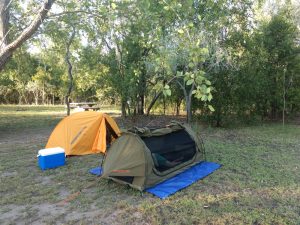 before we even set up camp we had a short walk around the area. A sudden loud rustle in the bushes next to us startled me. Turning around and expecting to see a wallaby, my daughter tells me I wouldn’t want to know what made that noise. On further enquiry she tells me it was a rather large snake, and I began to seriously wonder about moving our campsite further away from said snake.
before we even set up camp we had a short walk around the area. A sudden loud rustle in the bushes next to us startled me. Turning around and expecting to see a wallaby, my daughter tells me I wouldn’t want to know what made that noise. On further enquiry she tells me it was a rather large snake, and I began to seriously wonder about moving our campsite further away from said snake.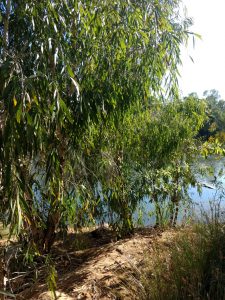 My uneasiness only increased as the evening rolled on and in particular when we came face to face with another snake only a few metres from our tents. Still, I wandered why the uneasiness was there in the first place. Was I sensing a spiritual presence? Was it simply that everything seemed strange and unfamiliar? Or perhaps the absence of other humans? Was I simply tired and misreading my intuition? Was it FEAR welling up and testing my inner strength?
My uneasiness only increased as the evening rolled on and in particular when we came face to face with another snake only a few metres from our tents. Still, I wandered why the uneasiness was there in the first place. Was I sensing a spiritual presence? Was it simply that everything seemed strange and unfamiliar? Or perhaps the absence of other humans? Was I simply tired and misreading my intuition? Was it FEAR welling up and testing my inner strength?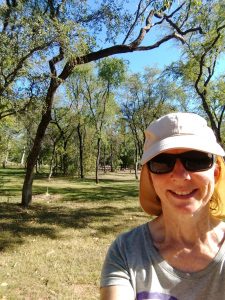 And so I survived. In fact I thrived and had possibly the best sleep so far on my April Adventure. I awoke before dawn, spent a couple of hours silently meditating, embracing my surroundings and feeling entirely captivated by what seemed so haunting and difficult the day before. I feel an immense sense of satisfaction that I didn’t allow my anxiety to rule and limit me. I chose to respect it but also to stand up to it. In doing so I’ve come to know an amazing spiritual aspect of this sacred land which I may not ever understand, but I can accept it and embrace it. And when I do that, I also accept and embrace myself.
And so I survived. In fact I thrived and had possibly the best sleep so far on my April Adventure. I awoke before dawn, spent a couple of hours silently meditating, embracing my surroundings and feeling entirely captivated by what seemed so haunting and difficult the day before. I feel an immense sense of satisfaction that I didn’t allow my anxiety to rule and limit me. I chose to respect it but also to stand up to it. In doing so I’ve come to know an amazing spiritual aspect of this sacred land which I may not ever understand, but I can accept it and embrace it. And when I do that, I also accept and embrace myself.
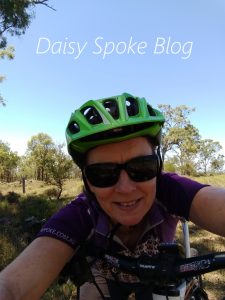 Daily exercise and general physical activity are crucial elements of feeling good. Just as some people might need to diligently take medication every day, I need to exercise every day. Exercise is nature’s way of stimulating the hormones which aid concentration, problem-solving, sleep, digestion, and mood. This daily dose of exercise rebalances our body’s systems resulting in wide-ranging benefits that no single medication can provide. The research is absolutely clear that regular medium to high intensity exercise can have a profound effect on health AND happiness.
Daily exercise and general physical activity are crucial elements of feeling good. Just as some people might need to diligently take medication every day, I need to exercise every day. Exercise is nature’s way of stimulating the hormones which aid concentration, problem-solving, sleep, digestion, and mood. This daily dose of exercise rebalances our body’s systems resulting in wide-ranging benefits that no single medication can provide. The research is absolutely clear that regular medium to high intensity exercise can have a profound effect on health AND happiness.

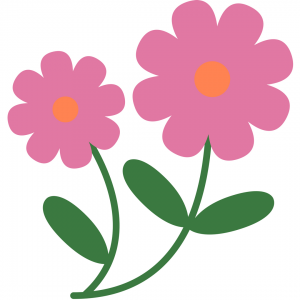 Click here to read my last blog post
Click here to read my last blog post 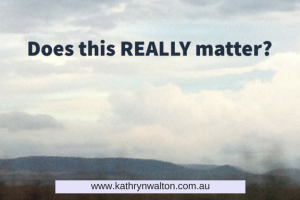
 example of mine was
example of mine was 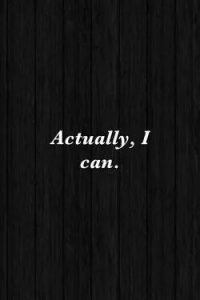
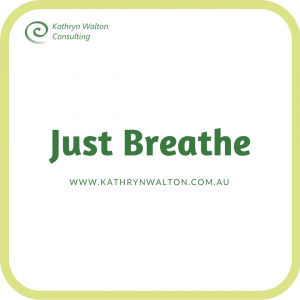 You can collect them from songs, poems, books and social media in addition to listening to your own inner wisdom. Write them on sticky notes, in a journal or diary, print out visual reminders to stick around your home or workplace, or even use them as screen savers and wallpapers on your electronic devices. Some examples include “Just do it”, “One drop raises the ocean”, “Keep it simple”, “Just breathe”, “Stand tall”.
You can collect them from songs, poems, books and social media in addition to listening to your own inner wisdom. Write them on sticky notes, in a journal or diary, print out visual reminders to stick around your home or workplace, or even use them as screen savers and wallpapers on your electronic devices. Some examples include “Just do it”, “One drop raises the ocean”, “Keep it simple”, “Just breathe”, “Stand tall”.
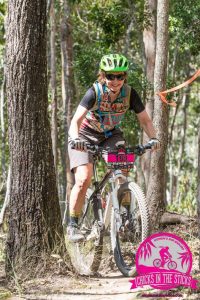 lying on the beach, your stresses trickling away into the sand beneath you) or to help you progress towards a goal (eg visualise yourself speaking in front of an audience, feeling confident, upright posture, smiling, relaxed). When I’m feeling nervous about riding my bike on a particular section of track, I stop for a few moments and picture myself riding it the way I want it to go, as if I’m watching a short video of myself successfully negotiating that section. It truly is a powerful mind-based strategy and one you can use in every area of your life.
lying on the beach, your stresses trickling away into the sand beneath you) or to help you progress towards a goal (eg visualise yourself speaking in front of an audience, feeling confident, upright posture, smiling, relaxed). When I’m feeling nervous about riding my bike on a particular section of track, I stop for a few moments and picture myself riding it the way I want it to go, as if I’m watching a short video of myself successfully negotiating that section. It truly is a powerful mind-based strategy and one you can use in every area of your life.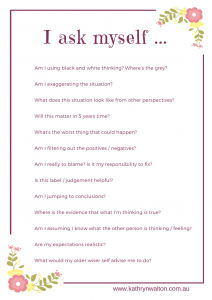 the mix. And to help you keep your strategies in play, I’ve created a free printable for you. “I ask myself …” is a beautiful keepsake of the helpful questions listed above. You can
the mix. And to help you keep your strategies in play, I’ve created a free printable for you. “I ask myself …” is a beautiful keepsake of the helpful questions listed above. You can 

 Kathryn Walton shares information and reflections in Daisy Spoke that connect, inspire and self-empower women to make healthy choices for themselves.
Kathryn Walton shares information and reflections in Daisy Spoke that connect, inspire and self-empower women to make healthy choices for themselves.